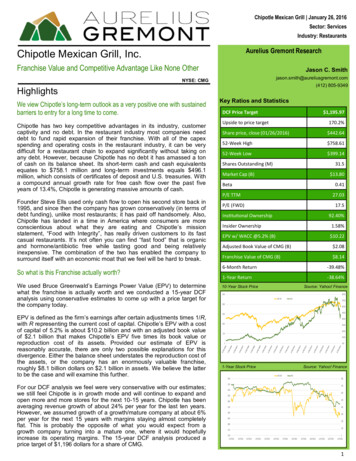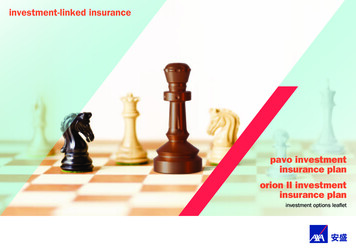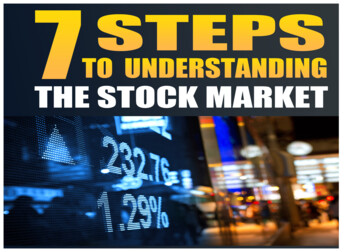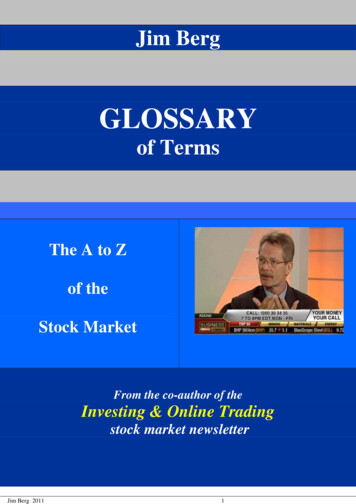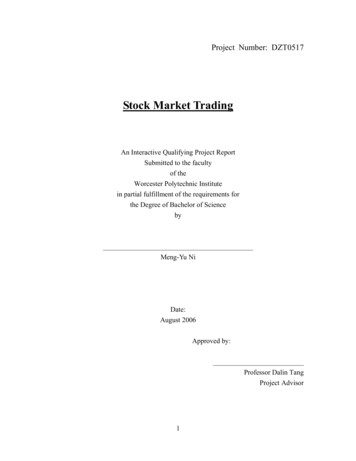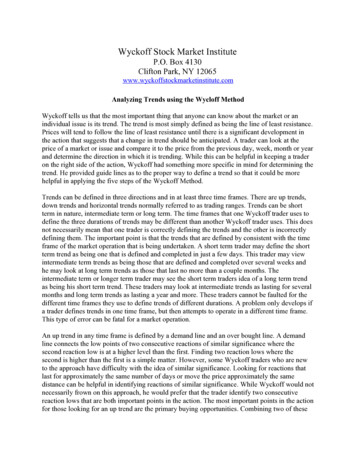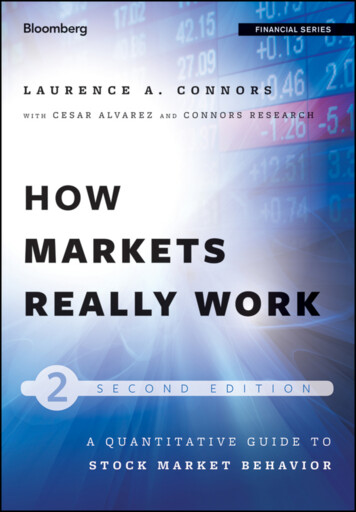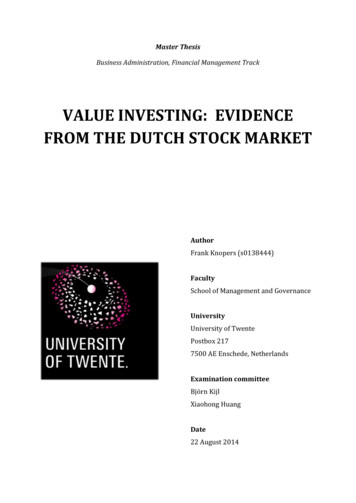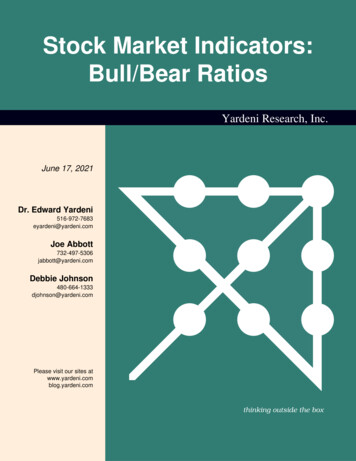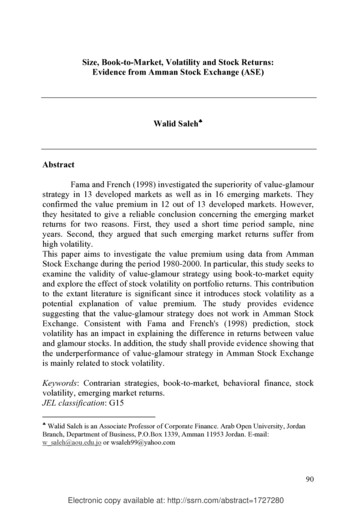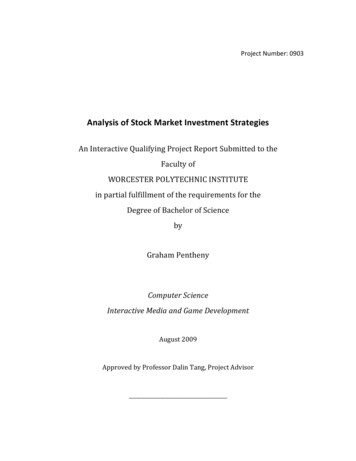
Transcription
Project Number: 0903Analysis of Stock Market Investment StrategiesAn Interactive Qualifying Project Report Submitted to theFaculty ofWORCESTER POLYTECHNIC INSTITUTEin partial fulfillment of the requirements for theDegree of Bachelor of SciencebyGraham PenthenyComputer ScienceInteractive Media and Game DevelopmentAugust 2009Approved by Professor Dalin Tang, Project Advisor
Table of ContentsI. Acknowledgements 4II. Abstract 5III. List of Figures. 6IV. List of Tables .81. Introduction .101.1 Goals .101.2 History of the Stock Market .101.3 Pros and Cons of Financial Investment .112. Financial Investment Opportunities 132.1 Stocks .132.2 Bonds .142.3 Certificates of Deposit .152.4 Mutual Funds .163. Stock Market Trading Strategies .173.1Day Trading . .173.2 Swing Trading 184. Simulated Investments and Their Results .194.1 Goals and Strategies .194.2 Company Profiles . 194.2.1 Apple Inc. .194.2.2 Microsoft Corp. .204.2.3 Raytheon Company .224.2.4 Google Inc. .234.2.5 Electronic Arts Inc. .244.2.6 NVIDIA Corp. .252
4.2.7 Intel Corp. 264.2.8 Advanced Micro Devices, Inc. .274.2.9 Yahoo! Inc. .284.3 Simulation 1: Swing Trading .294.3.1 Week 1 294.3.2 Week 2 354.3.3 Week 3 374.3.4 Week 4 394.3.5 Summary .414.4 Simulation 2: Day Trading .424.4.1 Week 1 424.4.2 Week 2 454.4.3 Week 3 .484.4.4 Week 4 504.4.5Summary .535. Conclusion .55References .57Appendix: Complete Transaction Record .593
I. AcknowledgementsI would like to thank Dr. Dalin Tang, Professor of Mathematical Sciences andBiomedical Engineering, Worcester Polytechnic Institute, for his advisement overthis project. I would also like to thank my friends and family for their support.4
II. AbstractThis investigation focused on what makes an investor profitable in the stockmarket. A3‐week investment simulation was conducted, utilizing day trading andswing trading strategies. The factors that attributed to the success of the simulationwere analyzed, and used to increase investing power and ability. The knowledgegained through this experiment will be used to make intelligent and informedinvestment decisions in the future.5
III. List of FiguresFigure 1: Apple Inc. (NASDAQ:AAPL) Year‐To‐Date Price Chart .20Figure 2: Microsoft Corp. (NASDAQ:MSFT) Year‐To‐Date Price Chart .21Figure 3: Raytheon Company (NYSE:RTN) Year‐To‐Date Price Chart 22Figure 4: Google Inc. (NASDAQ:GOOG) Year‐To‐Date Price Chart .24Figure 5: Electronic Arts Inc (NASDAQ:ERTS) Year‐To‐Date Price Chart .25Figure 6: NVIDIA Corp. (NASDAQ:NVDA) Year‐To‐Date Price Chart .26Figure 7: Intel Corp. (NASDAQ:INTC) Year‐To‐Date Price Chart 27Figure 8: Advanced Micro Devices, Inc. (NYSE:AMD) Year‐To‐Date Price Chart .28Figure 9: Yahoo! Inc. (NASDAQ:YHOO) Year‐To‐Date Price Chart 29Figure 10: Apple Inc. (NASDAQ:AAPL) Price Chart (June 9th ‐ June 19th, 2009) .30Figure 11: Google Inc. (NASDAQ:GOOG) Price Chart (June 9th ‐ June 19th, 2009) .32Figure 12: Ratheyon Corp. (NYSE:RTN) Price Chart (June 9th ‐ June 19th, 2009) .33Figure 13: Google Inc. (NASDAQ:GOOG) Price Chart (June 30th ‐ July 10th, 2009) 38Figure 14: Ford Motor Co. (NYSE:F) Price Chart (June 17th ‐ June 27th 2009) 44Figure 15: Rockwell Medical Technologies (NASDAQ:RMTI) Price Chart(June 23rd – July 3rd, 2009) . .466
Figure 16: Apple Inc. (NASDAQ:AAPL) Price Chart (June 30th ‐ July 10th, 2009) .49Figure 17: Novell Inc. (NASDAQ:NOVL) Price Chart (June 30th ‐ July 10th, 2009) .50Figure 18: Google Inc. (NASDAQ:GOOG) Price Chart (July 7th ‐ July 17th, 2009) 527
IV. List of TablesTable 1: AAPL Transactions (June 17 – June 26, 2009) . . 30Table 2: MSFT Transactions (June 17 – June 26, 2009) .31Table 3: GOOG Transactions (June 17 ‐ June 24, 2009) 32Table 4: INTC, NVDA, ERTS, YHOO, AMD Transactions (June 17th –June 26th,2009) .34Table 5: GOOG Transactions (June 24 ‐ June 26,2009) .35Table 6: RTN, GOOG, AAPL Transactions (June 29th ‐ July 3rd, 2009) .36Table 7: AAPL, GOOG, MSFT Transactions (July 7th, 2009) .37Table 8: AAPL, GOOG, MSFT Transactions (July 9th, 2009) .38Table 9: AAPL, NOVL Transactions (July 15th, 2009) .39Table 10: NOVL, AAPL Transactions (July 16th, 2009) 40Table 11: GOOG Transactions (July 17th, 2009) .40Table 12: CTV, CSX Transactions (June 23rd, 2009) .42Table 13: F Transactions (June 23rd, 2009) 43Table 14: RHT, TCK Transactions (June 25th, 2009) .44Table 15: GOOG, YHOO, MSFT Transactions (June 26th, 2009) .458
Table 16: RMTI Transactions (June 29th, 2009) .46Table 17: GOOG Transactions (July 1st, 2009) .47Table 18: GOOG, AAPL Transactions (July 6th, 2009) .48Table 19: NOVL Transactions (July 10th, 2009) .49Table 20: ORCL, AAPL Transactions (July 14th, 2009) .51Table 21: INTC, GOOG Transactions (July 16th, 2009) .51Table 22: F Transactions (July 17th, 2009) .529
1. Introduction1.1GoalsThe main goals of this project were to investigate possible investmentopportunities, logically weigh their respective risks and benefits, and make educatedinvestment decisions. A detailed understanding of the risks and opportunities for highreturn presented in each investment opportunity were obtained through extensive researchand analysis. This knowledge will aid in the future selection and execution of intelligentinvestments.A 3-week, 100,000 simulated stock market investment was made.Thissimulated investment tested the strategies researched, and helped in the understanding ofthe stock market in general. This experience facilitated the identification and anticipationof market trends, and thusly influenced future investment decisions.1.2History of the Stock MarketA stock market is “a place where stocks, bonds, or other securities are bought andsold [1].” A share of stock, informally referred to as “stock,” is a share in the ownershipof a corporation. Stocks entitle the owner to voting rights in major company decisions.Stocks can be bought and sold at a price determined by the financial success of thecorporation and the overall demand for the corporation’s stock. A bond is essentially aloan from the investor to an individual or organization, often the government, whichpromises to repay the debt with interest at a later date.10
The New York Stock Exchange (NYSE) was the first stock market to beestablished in the United States, tracing its roots back to 1792. The NYSE is also thelargest stock exchange in the world in terms of capital invested.The combinedcapitalization of all companies listed in the NYSE as of May 2009 is 10.4 trillion [2].Over 419 billion stocks are traded each year, at an average price of 24.87 per share [2].The financial well being of the United States is often judged by the performance of stocksin the New York Stock Exchange.A stock market crash is a sudden decline in the average price of stock. Panickedinvestors withdrawing their money, as well as underlying economic instability drive stockmarket crashes. The great 1929 crash of the NYSE was a primary cause of the GreatDepression, the worst economic crisis the United States has ever seen. More recently, theNYSE crash of 2008 was caused primarily by securities on defaulted loansgiven tounder-qualified individuals. Many large banks and loan-issuing organizations collapsedbecause of these defaulted, “sub-prime” loans. The crash of the NYSE affected theeconomies of many other countries as well, leading to the world financial crisis of 2008.1.3Pros and Cons of Financial InvestmentInvesting money into unpredictable, unstable, and uncontrollable facets can beextremely risky. Like the lottery, the success of stock market trading is partly attributedto luck.Many people have lost vast amounts of money through poor investmentdecisions that they’ve made. Recently, investors with shares in loan-giving companiesand American car manufacturers, which were previously a fairly stable investment, have11
suffered severe losses due to the economic crisis. Investors must understand and acceptthis risk as an intrinsic part of investing.There are, however, attractive benefits to successful financial investments. Withintelligent decisions, investing can yield significant capital gains, stability, and security.By analyzing the trends of the stock market, the companies one is invested in, and byfollowingan investment strategy, one can be successful in the stock market. There hasbeen much research into various ways of analyzing the stock market as a means offacilitating intelligent investment decisions. These “intelligent decisions” are paramountto the success of an investment, and will be examined in this experiment.12
2. Financial Investment Opportunities2.1 Shares of StockThe most well-known investment opportunity is shares of stock in a company.The general public is not allowed to trade stock in the New York Stock Exchange;instead the public trades through stockbrokers. Stockbrokers will buy or sell stock onbehalf of an individual for a commission, and often distinguish themselves by theinvestment advice they give their customers. The popularity of the Internet has facilitatedwebsites offering a means for customers to trade stock for a minimal fee (usually around 10 per trade). The Internet has also broadened the trading power of the stock exchange,allowing for millions of shares to be bought and sold each day.Investment in stocks can be risky. The return on investment (ROI) of stock canbe hard to predict, as the price of stock is determined by the financial success of thecompany, the demand for that company’s stock by investors, and the overall confidenceinvestors have in the market at a given moment. Investment in the stock market dependsas much upon factual, logical decisions as well as “gut-feeling” emotional ones. For thisreason, there are many stock market investment strategies that help investors make toughdecisions. Investors may choose to have their stock “portfolio” (the investor’s collectionof stocks) managed by their stockbroker, thereby removing the burden and responsibilityfrom the investor. Many stockbrokers advertise a guaranteed yearly return percentage asan incentive to invest money with them. The investor trusts their stockbroker to makesuccessful investment decisions on their behalf, forfeiting a portion of the return ascommission.13
Because of its relative unpredictability and therefore inherent possibility for hugereturns, the stock market is one of the most popular investment decisions among privateinvestors. The stock market’s constant fluctuation empowers investors with a multitudeof opportunities for substantial profits.This possibility of high returns and theunpredictability of the market are enticing to excitable investors, however with wisedecision-making, the stock market can be a stable, long-term investment opportunity aswell.2.2 BondsBonds are a loan, granted by the investor (“the holder”), to a corporation orindividual (“the issuer”, usually the government).The loan agreement includes aspecified amount of time, after which the bond is said to “mature.” A specified amountof interest is aggregated semi-annuallyduring the time before the bond matures, afterwhich no further interest is accrued. Once the bond has matured, the holder can cash thebond and regain the principle plus accrued interest. The holder usually cannot “cash” thebond before the time it matures without facing a penalty, often resulting in an overall lossfor the investor.Due to their guaranteed ROI, bonds are stable assets in an investor’s portfolio.Investors may also choose to invest in “bond funds,” where a third party broker invests inthe bonds of many companies.The private investor takes a stake in the principleinvestments made by the broker, and receives a portion of the earnings along with theirprinciple. Bond funds can be a more profitable choice for private investors because a14
brokerage can often negotiate the interest of a bond to a higher rate than would beavailable for a private investor.Because of bonds’ stability, guaranteed ROI, andbecause they are unaffected by the stock market,bonds are popular as long-terminvestments, and during uncertain financial times.2.3Certificates of DepositCertificates of deposit (informally referred to as “CDs” or “CODs”) areinvestments made in banks or credit unions in the form of a long-term savings account.A COD works very much in the
Like the lottery, the success of stock market trading is partly attributed to luck. Many people have lost vast amounts of money through poor investment decisions that they’ve made. Recently, investors with shares in loan-giving companies and American car manufacturers, which were previously a fairly stable investment, have 12 suffered severe losses due to the economic crisis. Investors must .

